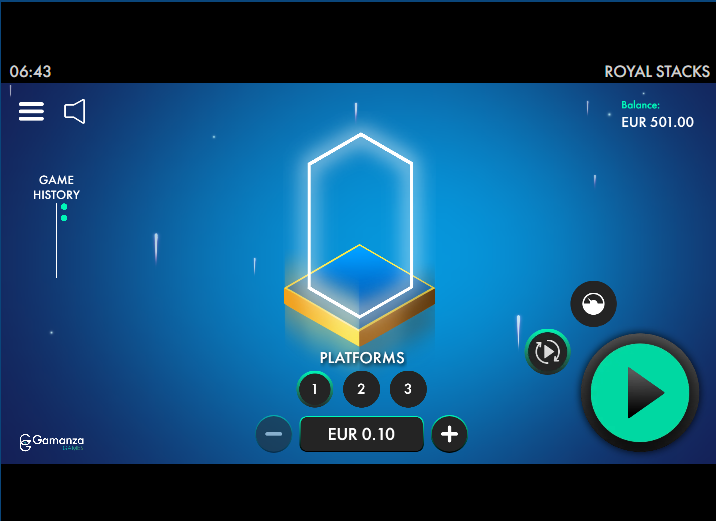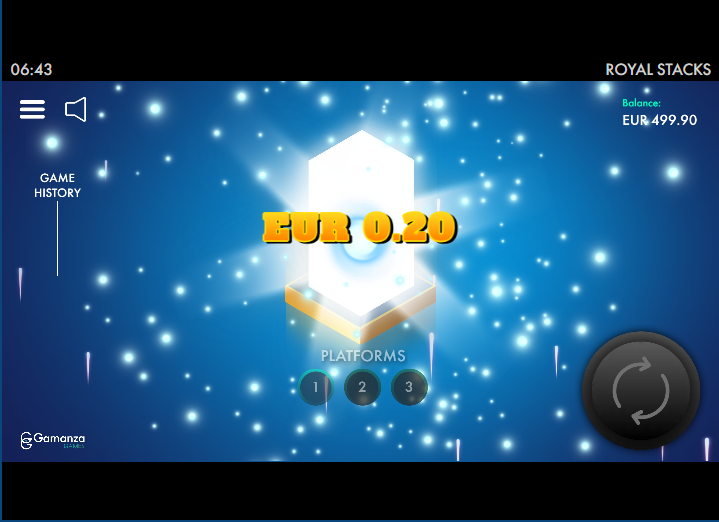Royal Stacks by Gamanza Games redefines the online slot format by replacing traditional reels with a geometric stacking challenge. The game operates within a minimalist, abstract theme, presenting a serene atmosphere with its clean visuals and focus on form. Instead of a standard grid, gameplay unfolds on one to three platforms where the objective is to build with falling gold pieces. Players achieve wins by matching a predetermined silhouette with these pieces, creating a distinct puzzle-like experience. It features a competitive RTP of 96.11%, offering a fair mathematical model for its outcomes. The high volatility design means payouts can be infrequent but significant, driven by a paytable that rewards complex constructions. Its primary feature is the Multi-Platform system, allowing players to manage up to three stacking challenges at once. This title appeals to players who value mechanical novelty and strategic pacing over narrative-driven slots.
Gamanza Games presents Royal Stacks, a title that consciously steps away from the established conventions of reel-based slot machines. This game discards paylines, spinning symbols, and familiar character-driven themes in favor of a mechanism centered on spatial reasoning and probability. The primary objective is not to align icons but to construct a stack of falling gold pieces that conforms to a predetermined silhouette. This foundational difference sets it apart from the majority of titles available for online play. Its appeal is rooted in its abstract, almost puzzle-like nature, focusing on the core dynamic of risk and reward through an unconventional lens. The game’s design choices, from its multi-platform system to its highly unconventional payout table, signal an experience crafted for a player who values mechanical novelty over narrative immersion.

A Departure from Reels: Core Gameplay and Payout Structure
The central mechanic of Royal Stacks is refreshingly direct. At the start of each round, a hollow, glowing outline of a shape appears on a pedestal. Subsequently, pieces of gold begin to descend from the top of the screen. The player's goal is to successfully fill this outline. A win is registered when the accumulated pieces form a pile that either perfectly matches the target shape (100% fill) or slightly exceeds it. This allowance for a minor overfill is a subtle but significant design choice, providing a small margin of error that mitigates the frustration of near-perfect attempts. The process is a continuous loop of setting a stake, observing the falling pieces, and awaiting the outcome of the stack's formation.
The game's strategic depth comes from the composition of the falling gold pieces. They are not uniform; instead, they appear in three distinct sizes, each with a fixed probability of dropping. The largest piece, designated as a “half,” has a 50% chance of appearing. A medium “fifth” piece has a 20% chance, and the smallest “tenth” piece has a 10% chance. This weighted distribution is the game's true random number generator. Players do not choose the pieces; they must work with the sequence provided, making each round a small-scale exercise in adapting to randomness. The sequence of these pieces directly influences the efficiency and possibility of completing the target shape, forming the basis of the game's challenge and potential payouts.
The payout system in Royal Stacks is perhaps its most peculiar and thought-provoking element. It is not tied to symbol combinations but to the number of gold pieces used to complete the shape. The paytable exhibits a non-linear, almost counter-intuitive progression that rewards both extreme efficiency and complex construction. For instance, completing a shape with just two pieces yields a 2x payout on the stake. Curiously, using four pieces results in a lower payout of 1.5x. This specific detail is critical; it suggests that the game places a high value on the ideal combination of two “half” pieces, an outcome that is statistically frequent but not guaranteed. The payout then climbs steadily, with 5 pieces awarding 2.5x, 6 pieces 4x, and so on, until it reaches two massive leaps at the higher end: completing a shape with 9 pieces awards a substantial 100x payout, while a perfect 10-piece construction triggers the maximum multiplier of 1,000x. This structure creates a high-volatility environment where players will see frequent small returns, but the main draw is the potential for a very large payout from a complex, multi-piece solution.
The Multi-Platform System: Managing Up to Three Piles
A significant feature that alters the game's rhythm and strategic dimension is the option to play on multiple platforms simultaneously. Players can choose to operate one, two, or three stacking areas at the same time. Activating additional platforms means the total stake for the round is multiplied accordingly, but it also triples the activity on screen. This is more than a cosmetic choice; it fundamentally changes the player's engagement and risk exposure. Playing on a single platform allows for a more focused, methodical pace, where attention is undivided. It is suitable for players who prefer to analyze each round in isolation.
Activating all three platforms transforms the game into a much faster-paced affair. With three shapes to fill and pieces falling for each, the screen becomes a dynamic field of parallel challenges. This increases the cognitive load but also accelerates the rate of play dramatically. For players seeking higher stimulation and willing to accept the higher per-round stake, the three-platform mode provides a more intense session. It effectively allows three chances to win within the same time frame as a single-platform round. This choice between focused concentration and high-volume action allows players to tailor the game's intensity to their personal preference, a level of control not commonly found in traditional slot formats.
Visual Presentation and Atmospheric Design
The aesthetic of Royal Stacks is defined by a clean, minimalist approach. The visual field is uncluttered, dominated by a deep blue gradient background populated with softly glowing, upward-drifting particles. This creates a serene, almost ethereal atmosphere that feels more akin to a modern digital puzzle application than a boisterous casino game. The central game elements—the golden pedestals and the bright, neon-white outlines of the target shapes—are rendered with sharp, clean lines. There are no extraneous characters, elaborate backdrops, or narrative animations. This deliberate visual restraint serves a functional purpose: it directs the player's entire focus to the geometric task at hand.
Animation is smooth and purposeful. The gold pieces fall with a steady, predictable motion, and a successful stack is celebrated with a bright flash of light and a clear, numerical display of the win amount. The visual feedback is immediate and unambiguous. The user interface elements, such as the bet adjustment controls and the spin button, are discreetly placed and follow the same minimalist design language. The overall effect is one of polish and precision. By stripping away visual noise, Gamanza Games ensures that the player's attention is not diverted from the core stacking mechanic. The design philosophy is one of function over flair, where the visual presentation directly supports and enhances the clarity of the gameplay.
Understanding the Mechanics: A Closer Look at the Rules
To fully grasp the game's behavior, it is essential to internalize the relationship between the piece probabilities and the target shapes. The 50%/20%/10% drop rates for the half, fifth, and tenth pieces, respectively, are the mathematical heart of the game. A round's outcome is entirely dependent on the random sequence of these pieces and whether they can geometrically fit into the presented silhouette. A player might receive a sequence of small pieces when a large one is needed, or vice-versa, introducing the core element of chance. The interaction between the various piece sizes and the specific geometry of a target shape can present some complexity. If the relationship between the pieces and how they combine to form a winning stack is not immediately apparent, a player can launch the Royal Stacks demo version and access the detailed game rules by clicking the information icon, often marked with an “i,” for a complete breakdown from the developer.
Beyond the primary mechanic, the game incorporates several standard convenience features. An Autoplay function allows players to configure a set number of rounds to proceed automatically, which is useful for longer sessions. A Fast Mode setting reduces the animation time, speeding up the process of pieces falling and stacks resolving. Given the piece-by-piece nature of the gameplay, this option is particularly effective for players who prefer a more rapid succession of outcomes. The game also includes a Bet History log, which displays the results of the last ten rounds played. This tool provides a quick-reference summary of recent activity, allowing players to track their progress and observe outcome frequencies over a short period.

Developer Insight and Game Parameters
Royal Stacks is a product of Gamanza Group AG, a developer based in Switzerland. The game serves as a strong example of the company's willingness to experiment with formats that exist outside the mainstream slot machine paradigm. By developing a title based on a stacking mechanic, Gamanza demonstrates an interest in attracting players who may be fatigued by the repetition of reel-based gameplay and are searching for a different kind of online gaming entertainment. This approach shows a commitment to diversifying the market with skill-adjacent, puzzle-like experiences.
From a technical standpoint, the game is built on solid statistical foundations. The Return to Player (RTP) is listed at 96.11%, a figure that aligns with the industry average for fairness and places it on competitive footing with many conventional video slots. The betting range is exceptionally wide, starting from a minimum of €0.10 and extending to a maximum of €1,000.00 per round (on a single platform). This broad spectrum makes the game accessible to casual players with modest bankrolls as well as high-stakes players seeking larger potential returns. The maximum achievable win is capped at €250,000.00, providing a significant ceiling that gives context to the 1,000x multiplier for a 10-piece win. These transparent parameters provide experienced players with the data they need to assess the game's risk profile and potential. Royal Stacks ultimately succeeds as an analytical exercise in game design, offering a calculated and refreshing alternative for the discerning player.













